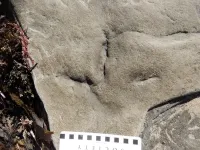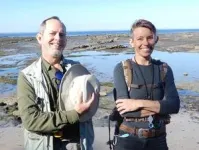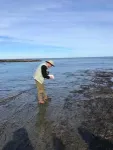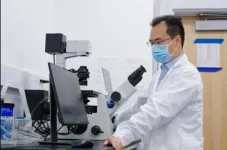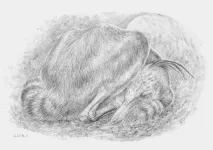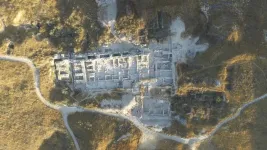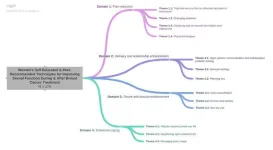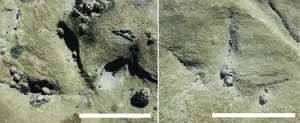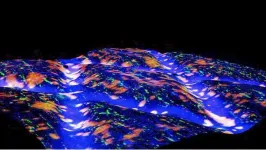(Press-News.org) The discovery of 27 avian footprints on the southern Australia coast — dating back to the Early Cretaceous when Australia was still connected to Antarctica — opens another window onto early avian evolution and possible migratory behavior.
PLOS ONE published the discovery of some of the oldest, positively identified bird tracks in the Southern Hemisphere, dated to between 120 million and 128 million years ago.
“Most of the bird tracks and body fossils dating as far back as the Early Cretaceous are from the Northern Hemisphere, particularly from Asia,” says Anthony Martin, first author of the study and a professor in Emory University’s Department of Environmental Sciences. “Our discovery shows that there were many birds, and a variety of them, near the South Pole about 125 million years ago.”
Martin is a geologist and paleontologist focused primarily on ichnology — the study of traces of life such as tracks, burrows, nests and tooth marks.
The international team of co-authors also includes researchers from Monash University and the Museums Victoria Research Institute in Australia; the Benemérita Normal School of Coahuila in Mexico and the Smithsonian Institution.
A possible migratory route
The 27 bird tracks vary in form and size and are among the largest known from the Early Cretaceous. They range from seven to 14 centimeters wide, which is similar to tracks of modern-day shorebirds, such as small herons and oystercatchers.
The tracks were found in the Wonthaggi Formation south of Melbourne. The rocky coastal strata mark where the ancient supercontinent Gondwana began to break up around 100 million years ago when Australia separated from Antarctica.
The polar environment at that time was a rift valley with braided rivers. Although the mean annual air temperature was higher during the Cretaceous than today, during the polar winters the ecosystem experienced deep, freezing temperatures and months of darkness.
The Wonthaggi avian tracks occurred on multiple stratigraphic levels, indicating a recurrent presence of a variety of birds. It also suggests seasonal formation of the tracks during polar summers, perhaps on a migratory route.
“The birds would likely have been stepping on soft sand or mud,” Martin says. “Then the tracks may have been buried by a gentle river flow that deposited more sand or mud on top of them.”
A scarcity of bird fossils
The Wonthaggi Formation is famous for its variety of polar dinosaur bones, although bird-fossil finds are extremely rare. The Cretaceous strata of the formation has yielded only one tiny bird bone — a wishbone — and a few feathers.
“Birds have such thin and tiny bones,” Martin says. “Think of the likelihood of a sparrow being preserved in the geologic record as opposed to an elephant.”
Birds are also lightweight and don’t leave much of a foot impression, he adds.
Martin and colleagues discovered two 105-million-year-old bird tracks in Australia’s Eumeralla Formation in 2013, making them the oldest from Australia at the time.
An eagle eye
Co-author Melissa Lowery, a local volunteer fossil hunter, first spotted some of the tracks in the current discovery in 2020. Dubbed “the doyenne of dinosaur discovery,” Lowery has found hundreds of bones and more than 100 dinosaur footprints.
“Melissa is incredibly skilled at finding fossil tracks,” Martin says. “Some of these tracks are subtle even for me, and I have lots of experience and training.”
Most of the tracks were only exposed at low tide and some of them were encrusted by marine life such as algae, barnacles and mollusks.
Due to international travel restrictions in Australia during the COVID-19 pandemic, Martin had to wait until 2022 before he could travel to the site to lead the analyses of the tracks.
He was joined in the field by co-authors Patricia Vickers-Rich, professor of paleontology at Monash University, and Thomas Rich, curator of vertebrate aleontology at Museums Victoria Research Institute. The couple have led a major effort since the 1970s to uncover fossils in the Australian state of Victoria and to interpret the biota of Gondwana.
Also assisting in the field analyses were co-authors Mike Hall, a geologist at Monash University, and Peter Swinkels, a taxidermist at Museums Victoria Research Institute and an expert at preserving specimens through moldings and casts.
The thinness of the toes relative to the track lengths, the wide angles between the toes and the thin sharp claws and rear toes on some of the tracks helped Martin to verify their avian identity.
Co-author Claudia Serrano-Brañas, a paleontologist at the Benemérita Normal School of Coahuila and the National Museum of Natural History, Smithsonian Institution, verified similarities between the Australian bird footprints and ancient bird footprints from other parts of the world.
Swinkels created resin casts of the Australian tracks that brought into greater relief some of the nuances of the impressions. The casts provide a tool for further study. They also serve to preserve the finds. The silty, sandstone beds containing the footprints are rapidly eroding under the coastal tides and waves.
“Seven of the tracks that Melissa found in 2020 are no longer there,” Martin says. “Some fossils, including tracks, are exposed only for a brief amount of time after being buried for millions of years. We humans have to rush in and document them before they disappear again.”
END
Birds set foot near South Pole in Early Cretaceous, Australian tracks show
Discovery provides oldest-known evidence for birds so far south
2023-11-15
ELSE PRESS RELEASES FROM THIS DATE:
University of Kentucky bioengineer designs tools to improve treatment for head and neck cancer
2023-11-15
LEXINGTON, Ky. (Nov. 15, 2023) — One University of Kentucky researcher is working to develop new techniques for radiation treatment to improve survival rates of patients with a specific type of cancer.
Caigang Zhu, Ph.D., is an assistant professor in the Department of Biomedical Engineering in the UK Stanley and Karen Pigman College of Engineering. He is also a member of the Molecular and Cellular Oncology Research Program at the UK Markey Cancer Center.
The National Institute of Dental and Craniofacial Research of ...
New plant hardiness map, used by gardeners nationwide and based on OSU climate data, unveiled
2023-11-15
CORVALLIS, Ore. – The U.S. Department of Agriculture today released its new Plant Hardiness Zone Map, the national standard by which gardeners can determine which plants are most likely to survive the coldest winter temperatures at a certain location.
The USDA describes the latest map, jointly developed by Oregon State University’s PRISM Climate Group and the USDA’s Agricultural Research Service, as the most accurate and detailed it has ever released.
PRISM, part of the OSU College of Engineering, stands for Parameter-elevation Regressions on Independent Slopes Model. The previous version of the plant hardiness map, also based ...
An engineered protein enhances memory
2023-11-15
Neuroscientists at the Faculty of Medicine and Surgery of the Catholic University, Rome, and the Fondazione Policlinico Universitario Agostino Gemelli IRCCS have genetically modified a molecule, the protein LIMK1, which is normally active in the brain, with a key role in memory. They added a "molecular switch" that is activated by administering a drug, rapamycin, known for its several anti-aging effects on the brain.
This is the result of a study published in the journal Science Advances, which involves the Catholic ...
New near-complete skeleton of a bird-like dinosaur is found in a position which suggests it slept like modern birds
2023-11-15
New near-complete skeleton of a bird-like dinosaur is found in a position which suggests it slept like modern birds
###
Article URL: https://journals.plos.org/plosone/article?id=10.1371/journal.pone.0293801
Article Title: A new alvarezsaurid dinosaur (Theropoda, Alvarezsauria) from the Upper Cretaceous Baruungoyot Formation of Mongolia provides insights for bird-like sleeping behavior in non-avian dinosaurs
Author Countries: Japan, Mongolia
Funding: Funding for this project was granted by Research Fellowships from the Japan Society for the Promotion of Science (JSPS 21J12938) (to KK) and Ami Koshimizu (Endless Glory Office Restart Co., Ltd.) (to KK). The funders had ...
Radiocarbon dating meets Egyptology and Biblical accounts in the city of Gezer
2023-11-15
New dates provide detailed insights into the timing of events in the ancient city of Gezer, according to a study published November 15, 2023 in the open-access journal PLOS ONE by Lyndelle Webster of the Austrian Academy of Sciences and colleagues.
Gezer is an ancient southern Levantine city, well known from Egyptian, Assyrian, and Biblical texts and associated with stories of power struggles and significant historical figures. It is also a rich archaeological site with abundant Bronze Age and Iron Age remains and with great potential for research into the daily lives of its denizens. Recent excavations at the site have uncovered a continuous stratigraphic ...
Women with breast cancer take sexual health into their own hands
2023-11-15
A third of users on a popular breast cancer support forum describe using peer-recommended or self-discovered techniques to improve sexual functioning, according to a study published November 15, 2023 in the open-access journal PLOS ONE by Christiana von Hippel from the Dana-Farber Cancer Institute and Harvard T.H. Chan School of Public Health, USA, and colleagues.
Over 75 percent of breast cancer survivors describe experiencing some degree of sexual dysfunction. Commonly prescribed interventions such as vaginal lubricants or numbing creams are only moderately ...
Australian footprints are the oldest known evidence of birds from southern regions
2023-11-15
Early birds had made it to southern polar environments by 120 million years ago, according to a study published November 15, 2023 in the open-access journal PLOS ONE by Anthony Martin of Emory University, USA and colleagues.
Cretaceous bird fossils are abundant and diverse in northern continents, but extremely rare in southern continents, regions that were once part of the landmass of Gondwana. This presents a challenge for paleontologists trying to understand the distribution of early birds. In this study, Martin and colleagues report ...
Treatment strategy for certain advanced prostate cancers shows promise in preclinical models
2023-11-15
Study Title: Targeting DNA methylation and B7-H3 in RB1-deficient and neuroendocrine prostate cancer
Publication: Science Translational Medicine [10.1126/scitranslmed.adf6732]
Dana-Farber Cancer Institute author: Himisha Beltran, MD
Summary: Epigenetic changes can cause prostate cancer to resist treatment by switching genes on or off. One epigenetic mechanism tags genes with DNA methylation marks. This process is mediated by molecules called DNA methyltransferases. These tags can alter gene expression in ways that promote tumors to grow and transition ...
Devil in the detail – What corporations aren’t disclosing about their C02 emissions
2023-11-15
A new study estimates most corporations are not reporting the full scope of their carbon footprint with many claiming to be ‘green’ despite a lack of reporting on Scope 3 key categories.
Though CO2 reporting is currently voluntary for most firms, corporations are under pressure from investors, regulators, politicians, non-profit organisations and other stakeholders to disclose and reduce greenhouse gas emissions (GHG).
The standard for greenhouse gas accounting, the Greenhouse Gas Protocol, is used worldwide to measure a company’s total carbon footprint with three levels of reporting.
The first measures the GHG emissions directly produced by a company ...
New ‘patch’ uses natural body motion to fix disc herniation
2023-11-15
PHILADELPHIA— A new biologic “patch” that is activated by a person’s natural motion could be the key to fixing herniated discs in people’s backs, according to researchers at the Perelman School of Medicine at the University of Pennsylvania and the CMC VA Medical Center (CMCVAMC). Combining years of work from many different projects, the “tension-activated repair patches” (TARPs) provide controlled release of an anti-inflammatory molecule called anakinra from microcapsules over time, which helped ...
LAST 30 PRESS RELEASES:
Cuffless blood pressure technologies in wearable devices show promise to transform care
AI-based tool predicts future cardiovascular events in patients with angina
Researchers map how the cerebellum builds its connections with the rest of the brain during early development
Routine scans could detect early prostate radiotherapy changes
Fairness in AI: Study shows central role of human decision-making
Pandemic ‘beneath the surface’ has been quietly wiping out sea urchins around the world
Tea linked to stronger bones in older women, while coffee may pose risks
School feeding programs lead to modest but meaningful results
Researchers develop AI Tool to identify undiagnosed Alzheimer's cases while reducing disparities
Seaweed based carbon catalyst offers metal free solution for removing antibiotics from water
Simple organic additive supercharges UV treatment of “forever chemical” PFOA
£13m NHS bill for ‘mismanagement’ of menstrual bleeds
The Lancet Psychiatry: Slow tapering plus therapy most effective strategy for stopping antidepressants, finds major meta-analysis
Body image issues in adolescence linked to depression in adulthood
Child sexual exploitation and abuse online surges amid rapid tech change; new tool for preventing abuse unveiled for path forward
Dragon-slaying saints performed green-fingered medieval miracles, new study reveals
New research identifies shared genetic factors between addiction and educational attainment
Epilepsy can lead to earlier deaths in people with intellectual disabilities, study shows
Global study suggests the underlying problems of ECT patients are often ignored
Mapping ‘dark’ regions of the genome illuminates how cells respond to their environment
ECOG-ACRIN and Caris Life Sciences unveil first findings from a multi-year collaboration to advance AI-powered multimodal tools for breast cancer recurrence risk stratification
Satellite data helps UNM researchers map massive rupture of 2025 Myanmar earthquake
Twisting Spins: Florida State University researchers explore chemical boundaries to create new magnetic material
Mayo Clinic researchers find new hope for toughest myeloma through off-the-shelf immunotherapy
Cell-free DNA Could Detect Adverse Events from Immunotherapy
American College of Cardiology announces Fuster Prevention Forum
AAN issues new guideline for the management of functional seizures
Could GLP-1 drugs affect risk of epilepsy for people with diabetes?
New circoviruses discovered in pilot whales and orcas from the North Atlantic
Study finds increase in risk of binge drinking among 12th graders who use 2 or more cannabis products
[Press-News.org] Birds set foot near South Pole in Early Cretaceous, Australian tracks showDiscovery provides oldest-known evidence for birds so far south
